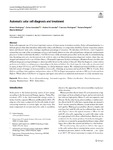Mostrar o rexistro simple do ítem
Automatic solar cell diagnosis and treatment
| dc.contributor.author | Rodriguez, Alvaro | |
| dc.contributor.author | Gonzalez-Val, Carlos | |
| dc.contributor.author | Fernández, Andrés | |
| dc.contributor.author | Rodríguez, Francisco | |
| dc.contributor.author | Delgado, Tamara | |
| dc.contributor.author | Bellman, Martín | |
| dc.date.accessioned | 2023-11-28T09:32:41Z | |
| dc.date.available | 2023-11-28T09:32:41Z | |
| dc.date.issued | 2021-04 | |
| dc.identifier.citation | Rodriguez, A., Gonzalez, C., Fernandez, A. et al. Automatic solar cell diagnosis and treatment. J Intell Manuf 32, 1163–1172 (2021). https://doi.org/10.1007/s10845-020-01642-6 | es_ES |
| dc.identifier.issn | 1572-8145 | |
| dc.identifier.uri | http://hdl.handle.net/2183/34352 | |
| dc.description.abstract | [Abstract]: Solar cells represent one of the most important sources of clean energy in modern societies. Solar cell manufacturing is a delicate process that often introduces defects that reduce cell efficiency or compromise durability. Current inspection systems detect and discard faulty cells, wasting a significant percentage of resources. We introduce Cell Doctor, a new inspection system that uses state of the art techniques to locate and classify defects in solar cells and performs a diagnostic and treatment process to isolate or eliminate the defects. Cell Doctor uses a fully automatic process that can be included in a manufacturing line. Incoming solar cells are first moved with a robotic arm to an Electroluminescence diagnostic station, where they are imaged and analysed with a set of Gabor filters, a Principal Component Analysis technique, a Random Forest classifier and different image processing techniques to detect possible defects in the surface of the cell. After the diagnosis, a laser station performs an isolation or cutting process depending on the detected defects. In a final stage, the solar cells are characterised in terms of their I–V Curve and I–V Parameters, in a Solar Simulator station. We validated and tested Cell Doctor with a labelled dataset of images of monocrystalline silicon cells, obtaining an accuracy and recall above 90% for Cracks, Area Defects and Finger interruptions; and precision values of 77% for Finger Interruptions and above 90% for Cracks and Area Defects. Which allows Cell Doctor to diagnose and repair solar cells in an industrial environment in a fully automatic way. | es_ES |
| dc.description.sponsorship | This project has received funding from the European Union's Horizon 2020 research and innovation programme under Grant Agreement No 679692. | es_ES |
| dc.language.iso | eng | es_ES |
| dc.publisher | Springer | es_ES |
| dc.relation | info:eu-repo/grantAgreement/EC/H2020/679692 | es_ES |
| dc.relation.uri | https://doi.org/10.1007/s10845-020-01642-6 | es_ES |
| dc.rights | Atribución 3.0 España | es_ES |
| dc.rights.uri | http://creativecommons.org/licenses/by/3.0/es/ | * |
| dc.subject | Solar cell manufacturing | es_ES |
| dc.subject | Automatic inspection | es_ES |
| dc.subject | Defect classification | es_ES |
| dc.subject | Electroluminescence imaging | es_ES |
| dc.subject | Random forest | es_ES |
| dc.subject | Random forest | es_ES |
| dc.subject | Gabor filters | es_ES |
| dc.title | Automatic solar cell diagnosis and treatment | es_ES |
| dc.type | info:eu-repo/semantics/article | es_ES |
| dc.rights.access | info:eu-repo/semantics/openAccess | es_ES |
| UDC.journalTitle | Journal of Intelligent Manufacturing | es_ES |
| UDC.volume | 32 | es_ES |
| UDC.issue | 4 | es_ES |
| UDC.startPage | 1163 | es_ES |
| UDC.endPage | 1172 | es_ES |
Ficheiros no ítem
Este ítem aparece na(s) seguinte(s) colección(s)
-
GI-RNASA - Artigos [193]






